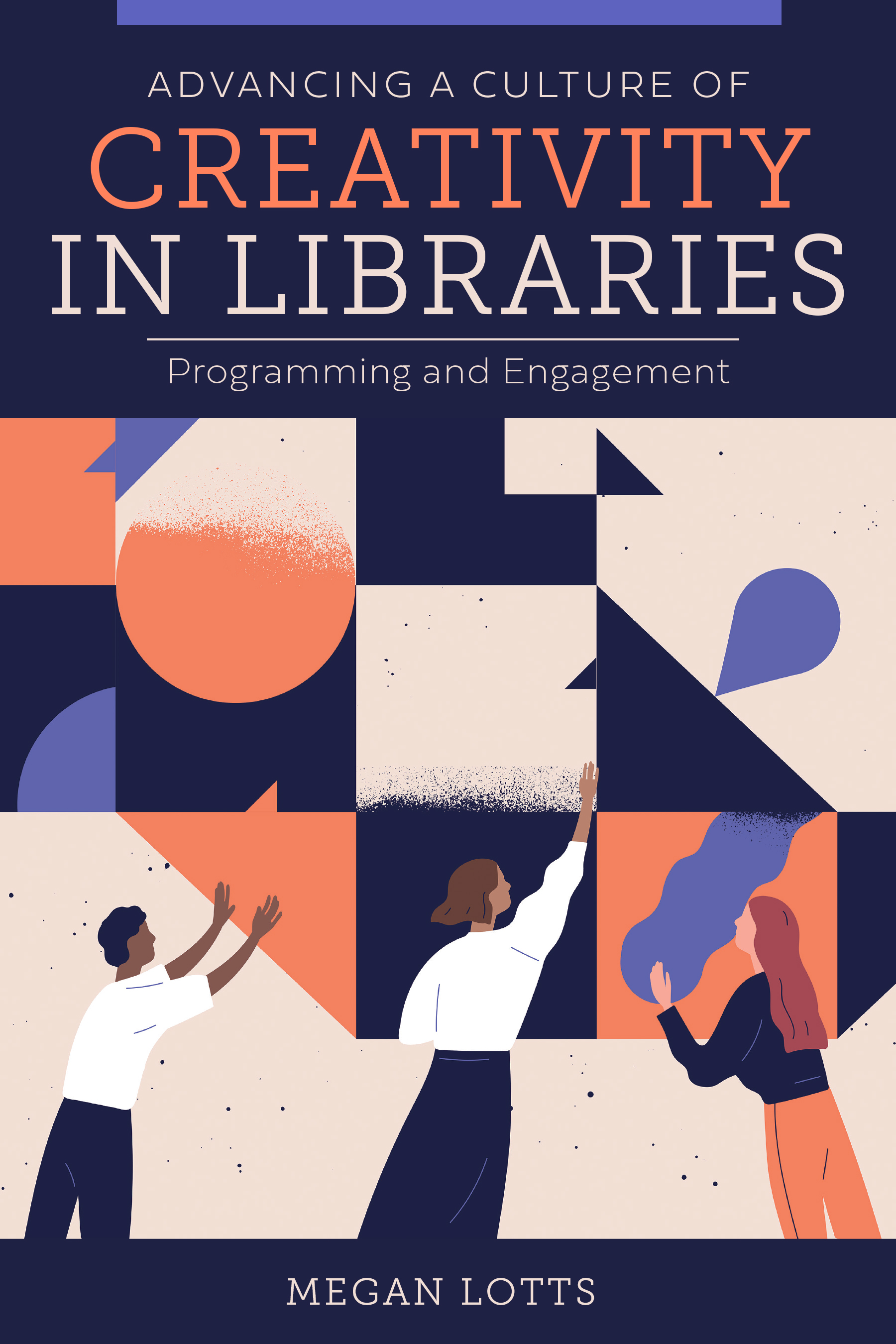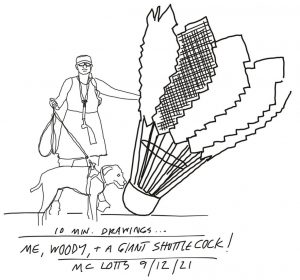Interviews with Authors
 Art librarian Megan Lotts recently published a new book entitled Advancing a Culture of Creativity in Libraries: Programming and Engagement. It gave us the idea to launch a new interview series about titles that Books We Read affiliates have written or are currently working on.
Art librarian Megan Lotts recently published a new book entitled Advancing a Culture of Creativity in Libraries: Programming and Engagement. It gave us the idea to launch a new interview series about titles that Books We Read affiliates have written or are currently working on.
Known for her imagination, creativity, and vision, Megan, who is an artist herself, advocates a culture of creativity in libraries in this book. An integral part of the Books We Read community on the Cook campus, she is a key contributor to outreach events in the Chang Science Library––whether it is a fun, on–campus event, such the Harry Potter Day, or an online Graphic Design workshop. She has always been willing to share her expertise on visual information literacy and image searches in a workshop or blog post. The Summer Tales Book Club benefited tremendously from her thoughtful comments on creative artwork during the session as well as her role as jury of the Creative Contest.
This book shows academic and public libraries the many benefits of nurturing a culture of creativity, offering hands-on guidance on encouraging cross-disciplinary collaboration, launching active-learning events that highlight collections and services, fostering goodwill and trust-building, and forming partnerships that promote library visibility. (Quote from publisher’s site)
Books We Read (BWR) asked Megan (MCL) as a recently published author about her experiences about the writing process.
BWR: At Rutgers, you are known as a librarian. But you are also an artist with many talents. What motivated you to switch to writing a book?
MCL: To be honest I’ve always struggled with writing, so taking on a book project was a HUGE undertaking for me. I’m a visual artist and reading is not my preferred method of learning. However, I was approached twice by an editor from ALA about writing this book and finally by the third ask I had tenure, I was ready, and said yes. But I also want to note, for me, taking on the task of writing a book included finding a writing coach, who was there for me when I needed to talk about ideas and helped me keep on track.
BWR: How long did it take for you to complete the manuscript from the inception of the idea?
MCL: This is a hard question to answer as I see this book as a reflection of the first 15 years of my career as a tenure track faculty librarian. From the time I signed the book contract to the time I turned in the final manuscript took 14 months. However, the overall time from invitation to submit a book proposal and having the book in hand took roughly 2 years.
BWR: You wrote the whole book during the pandemic, working also remotely full time. What inspired you the most the during the writing process? What kept you going on in the most difficult periods?
MCL: Not only was I writing a book and working an extremely time intensive job during the pandemic, but I was also serving in the role of RUL-NB Faculty Chair. Most of the time writing the book I was working 100–120-hour weeks and it was INTENSE. Honestly, I don’t know how I did it. I often wonder if writing the book is what kept me distracted during the longest days of the pandemic? It gave me something important and meaningful to focus on.
BWR: You claim that “creativity is not a superpower.” Instead, you say that “I am an artist because I dedicated time to learning and practicing the skills art requires,” providing hope for many of us! Who is the primary audience of your book?
MCL: The book is for anyone who is looking to engage more closely with creativity. Clearly this book is rooted in the field of librarianship and specifically academia. However, there is no question this book will be of value to any library, museum, non-profit organization, individual, or corporation that needs change.
BWR: Who else do you think can benefit the most? We agree that creative skills come handy in walks of life.
MCL: Honestly, I think this book is for anyone who wants to learn more about creativity and how to engage with community on a deeper level, as well as how to expand teaching and learning and think more about impact and assessment. But also, one will learn how to highlight collections, teach scholarly research concepts, and what’s possible in libraries in more dynamic and exciting ways.
BWR: Any creative process takes time from idea to fruition, and as such, has its ups and downs. What was the best part of writing this book? What kind of challenges, if any, did you have to overcome?
MCL: The best part of writing the book was the case studies also known as “Ideas in Action.” I was able to read about so much exciting work happening in the world of librarianship. But also touching on an earlier question, one of the aspects that kept me inspired was the interviews with individuals I was meeting virtually for the first time and others I had not seen in years. It was inspiring to hear their stories and how these individuals were engaging with their communities and making change.
BWR: We loved browsing what you call “Ideas in Action” in the Table of Contents. If there is one thing that you’d like readers to take away, what is your favorite case in the book?
MCL: I hope that every reader is inspired and walks away with something to think about. I love all the case studies also known as ideas in action, but I think one of my personal favorite chapters is the Bubbler. Madison Public Library and Trent Miller are really taking innovation and creativity to a whole new level. I am beyond inspired how they engage with and empower their communities. These folks are bringing their A game, and then some. There’s a story I share at the end of the Bubbler chapter which Miller shared with me, and it still makes me puddle up almost every time I read it.
BWR: Is there a story related to your creative writing process that you would like to share? I bet everyone likes to learn from other authors’ experiences, positive or negative.
MCL: Writing is a very physical process for me. Although I wrote and submitted the manuscript in Microsoft Word, I keep a sketch book for every writing project I undertake. This gives me a place to keep notes, make drawings, and work out my ideas. I went to college with a typewriter and not a fancy one, so I have developed some interesting ways of keeping track of information over the years and this has certainly been influenced by being a visual artist, librarian, and maker.
BWR: Let’s go back to the pandemic, quarantine, crazy hours, and obstacles to access resources. What kind of support did you receive from your direct environment?
MCL: I spent a lot of time walking my dogs. My partner Brady is a good cook, and I was fortunate to spend most of the pandemic working in a sun room filled with plants. But honestly my trick was getting up early and having at least 3 hours of writing under my belt before everyone else had their first cup of coffee or time to send a work-related email 😊. I also really appreciate my local colleagues who regularly checked in on me to make sure I kept my head above water and to those who contributed to the book.
BWR: With the book in hand now, is there anything you would do differently?
MCL: Hard to say, I’m still in the post writing honeymoon phase 😊.
BWR: In our guest author events in the summer, participants often looked for the wisdom and guidance from the author. What advice can you give to aspiring authors?
MCL: This is a tough question. I think every writing project is different and a new experience. I would tell anyone to be open to an organic process, know there will be hiccups along the way, and make sure to keep the project and writing fun. Also, get a coach, a buddy or someone you can check in with, even if you are writing the book alone. My writing coach was my rock, and we bonded in ways I didn’t expect. We really became friends during this project, as well as an inspiration to each other which really puddles me up 😊.
BWR: What’s next?
MCL: Right now, I’m sharing the book at conferences, invited speaking events, as well as working on new creative projects both at work and home. I also regularly work with Tara Maharjan from Special Collections/University Archives on creative projects. I’d say, due to the pandemic, we’ve been able to spend more time reflecting on this work as well as adapting these ideas for virtual audiences.
BWR: Thank you for your time. We at Books We Read wish you all the best to nurture your creativity for the benefit of all.
MCL: Thank you Books We Read program and for inviting me to share my thoughts! It’s always a treat to engage with this team, and your creativity and hard work are an inspiration to us all.
